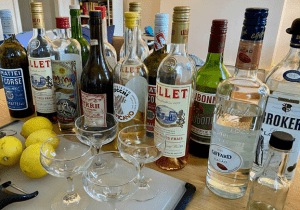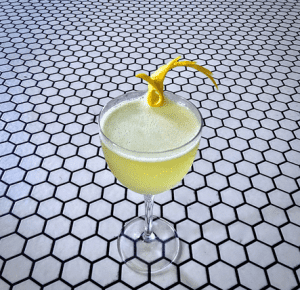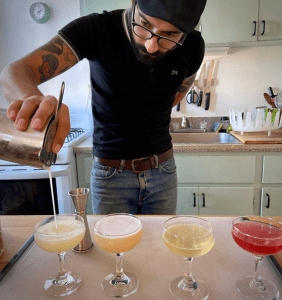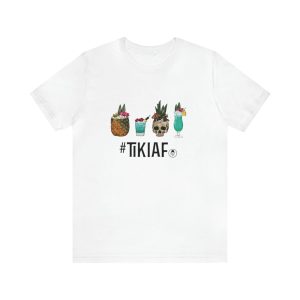The Bartender’s Guide to the Twentieth Century
Coming fresh off of my Corpse Reviver #2 comparison and heading into the icy winter months, I was left with quite a few open bottles of quinquina and Americano. I figured the next best use of these fortified wines would be a Twentieth Century comparison. After all, this drink was named after the 20th Century Limited, a luxury train that linked Chicago (my birthplace) to New York (my current home).
This one is a personal favorite of mine (serving as the inspiration for my Sno-Cone cocktail), but a cocktail that tends to throw most for a loop.
- 1.5 oz London Dry Gin
- .75 oz Lillet Blanc
- .75 oz Lemon Juice
- .75 oz Creme de Cacao White
Before you turn your nose up at the combination of gin, lemon, and crème de cacao, let’s get something out of the way. No, this does not taste like a Mudslide, Chocolate Cake Shot, Chocotini, or any other guilty pleasure chocolate cocktail or shooter you may have been hurt by in the past. This is not a cocktail designed to mask bad booze, nor was it born out of kitsch. Rather, it is an exceptionally refined and surprisingly elegant sour.
Chocolate-tinged sours are a rarity, the Twentieth Century and the Mulatta Daiquiri being the most notable in the category. On paper, the chocolate instantly makes it seem less approachable – reading “creme de cacao” may trigger warnings of sweet, thick cocoa. But if done properly, a Twentieth-Century shouldn’t be sweet or even particularly chocolatey.
Admittedly, the Twentieth Century is a tricky drink to balance as it can wind up too confectionery for a gin sour and too thin and acidic for a dessert cocktail. With that in mind, a well-executed Twentieth Century is a bright, high-acid sour with an underlying cacao note so subtle you probably won’t notice it until the finish. Far from dessert cocktails like the Grasshopper or Alexander, it shouldn’t be heavy, but rather, refreshing.
But wait. What if we’re spending too much time fussing over the crème de cacao? What if I told you the real trick to finding the perfect Twentieth Century lies in your choice of quinquina or Americano? What if by carefully selecting the right fortified wine you could create either a bright, bitter, citrusy sour with cacao notes dialed so far back they hardly offer a whisper of baking spice? What if you could create Black Forest Cake in a coupe?
Before we discuss the interplay between fortified wine and crème de cacao, we need to settle on a standardized recipe.
The Spec
The Twentieth Century was created by British bartender C.A. Tuck and was first published in William J. Tarling‘s Cafe Royal Cocktail Book in 1937.

The Cafe Royal Cocktail Book was essentially a handbook for and published by the UK Bartender’s Guild. While exact measurements are not specified, I have to wonder if each “part” was originally .5 oz, per the Corpse Reviver #2 it is derived from. Regardless, the recipe calls for equal parts lemon juice, crème de cacao, and quinquina with a double portion of gin. Sounds good, right?
Well, like many cocktails of the time, this one has been through a bit of rejiggering to update it for contemporary tastes and products commercially available. It’s interesting to note that while this is a riff on a Corpse Reviver #2, which has remained unchanged since its publication in 1930, contemporary bartenders seem to be all over the place when it comes to the Twentieth Century. You can probably blame the United States’ historically poor quality of white crème de cacao for this.
This also explains the Twentieth Century’s relative obscurity, having been mostly forgotten until the publishing of Ted Haigh‘s Vintage Spirits and Forgotten Cocktails in 2004.
Twentieth Century- 1.5 oz London Dry Gin
- .75 oz Lillet Blanc
- .75 oz Lemon Juice
- .5 oz Creme de Cacao white
Garnish
*Haigh describes the Twentieth Century as having a “sense of chocolate” rather than noticeably tasting of chocolate – he states that, depending on the palate of the imbiber, as little as a scant splash of crème de cacao is acceptable. While I agree wholeheartedly with his description of the flavors of this cocktail, I think it’s a bad idea to use less than a half-ounce of crème de cacao – the cocktail doesn’t have enough sugar to provide body or structure without it. More on that later.
Punch and Imbibe offer identical recipes to Haigh, but without the suggestion to further decrease the cacao. Imbibe has a second entry that dials the quinquina back by a half ounce, the same as Liquor.com’s recipe. Oddly, London-based Difford’s Guide also offers two different recipes, both of which call for an absurdly high 1-ounce pour of crème de cacao, and one substitutes dry vermouth in place of quinquina.
In recent print, both Meehan’s Bartender’s Manual and Death & Co‘s Cocktail Codex call for equal parts lemon, crème de cacao, and quinquina with a double portion of London Dry Gin. This uses the original proportions of the cocktail as published in 1937.
After trying several recipes with multiple quinquina, Americano, and crème de cacaos, the most universally balanced recipe out of the gate is C.A. Tuck’s original spec. Keeping the crème de cacao equal to the other ingredients doesn’t make the drink significantly more chocolatey, but it does add a lot more body which makes for a better, more balanced cocktail.
I will say Haigh’s cacao restraint is welcome when using lower quality crème de cacao like Llord’s, Dekuyper, or other overly sweet, synthetic-tasting, one-note liqueurs commonly found on bottom shelves. If this is the case, I’ll offer some suggestions on how to balance that out after the tasting notes.
Nuts and Bolts
This is the backbone of the drink and the hardest to get wrong. The gin provides a strong foundation, but ultimately the choice of fortified wine should guide the profile more than the gin.
That said, gins with some faint confectionary notes (e.g., cinnamon and licorice) work better than spicier gins (think coriander and peppercorn). The more citrus and juniper, the better. For example, Tanqueray 10’s lime-and-grapefruit profile works better than standard Tanqueray’s coriander spice.
As forgiving of a template as the Corpse Reviver #2 is, the Twentieth Century is even more forgiving on account of the extra gin. Wondering how a Twentieth Century remains balanced using the same proportions of sweet liqueur, fortified wine, and citrus, but doubling the gin? The answer lies in the proof!
Quality, full-strength orange liqueurs like Cointreau are not only as sweet as crème de cacao, but they usually clock in at 40% ABV, making them as strong as full-proof spirits. On the other hand, crème de cacao sits comfortably between 20% – 25% ABV.
Increasing the gin raises the proof of the cocktail, thus compensating for the weaker liqueur. The extra gin, especially if using a gin with a decent body, actually improves the texture and mouthfeel of the cocktail.
Despite the name “creme de cacao,” there is no cream anywhere near the tin. In French, crème refers to the “creamy” texture the liqueur achieves through the addition of sugar. Creme de cacao is simply chocolate liqueur, either clear (white) or brown (dark), made from cacao and vanilla.
For the most part, white crème de cacao is made by distilling cacao beans while dark crème de cacao extracts its cacao via maceration or percolation. Dark crème de cacao almost always gets its color from the addition of caramel which makes for a richer, sweeter, bolder expression. Most producers offer both varieties.
One notable exception is the much-loved Tempus Fugit Creme de Cacao which adds no artificial coloring and instead draws its ludicrously deep cacao flavors from both distilling cacao beans and macerating that distillate with even more cacao and vanilla beans.
Unfortunately, as delicious as Tempus Fugit’s Creme de Cacao is, it is the wrong style of cacao for a Twentieth Century.
Functionally, white and dark crème de cacaos serve different purposes. The softer, more delicate white crème de cacao fits the bill for a gin-based cocktail with acidic fortified wine and fresh citrus. Remember, a Twentieth-Century should not be chocolate-forward. A lighter style of crème de cacao ensures you get the chocolate and vanilla without battering the fortified wine or clashing with the lemon juice.
The question is, how much cacao do you want to taste? None? Some? Lots? Turns out you can adjust this simply by choosing the right fortified wine, rather than figuring out how to rejigger or rebalance around your crème de cacao.
As with any cocktail invented before 1985, the Lillet Blanc originally called for in this cocktail no longer exists. I find that today’s Lillet Blanc is usually outperformed by the comparable Cocchi Americano Bianco and Kina L’Aero D’Or, but still makes for delicious cocktails.
Regardless, there are 12 quinquina and Americano available on the US market and just about every one of them technically works, albeit very differently. I aim to identify which are best at satisfying expectations and personalized preferences alike.
As long as it is freshly squeezed, you can’t mess up this component of the drink. It is worth noting that every individual piece of fruit will be different. Some will be sweeter and less acidic (or vice versa), some will be milder all around, some will have some sulphuric funk.
One of the ways cocktail bars aim for consistency is to juice a batch of lemons and blend the juice for a uniform flavor. This eliminates the need to rejigger to compensate for the citrus variable.
I generally don’t like to use citrus twists on citrusy, shaken cocktails served up, finding them mostly unnecessary and wasteful. This is one cocktail I’ll make an exception for.
Beyond aesthetics, the purpose of a citrus twist garnish is to provide a citrus aromatic after the initial misting of oils over the surface of the cocktail is sipped off. If a citrus twist is inserted or dropped into a glass and makes contact with the actual cocktail, those oils will leach out and infuse into the drink, keeping it bright and lively as it warms or dilutes.
This makes perfect sense for stirred cocktails like Old Fashioneds or Negronis which are designed to sit for extended periods of time, but much less sense for drinks (like the Corpse Reviver #2) which should be, and usually are consumed before they warm and fall apart.
The Twentieth Century is not your standard sour or daisy. First, the ideal spec makes for a larger cocktail than a standard sour by a quarter of an ounce before dilution – and up to a half-ounce larger after dilution. A bigger cocktail means it will sit at room temperature longer, be held in warm hands longer, and will make more contact with warm lips. Those three things all lead to the warming of the cocktail.
As this particular cocktail warms, the sugars and baking spices from the crème de cacao and quinquina or Americano become more apparent. More sips mean the expression of lemon oil over the cocktail will be consumed before the cocktail is finished, necessitating the need for the citrus peel twist to continue brightening the nose and, consequently, the palate. The citrus of the peel then cuts through the slowly prevailing cacao, cinnamon, vanilla, etc.
The Experiment(s)
Like my Corpse Reviver #2 tasting, I first conducted this tasting at the end of 2019 sans Kina L’Aero D’Or, then again in the summer of 2020 to include it. After seeing how well the Corpse Reviver #2 worked with darker quinquina and Americano, I knew I would find similar results with the Twentieth Century. I prepared for the third and final tasting.
My final tasting aimed to determine the best version of the Twentieth Century, as well as the most successful non-traditional expressions. Every quinquina and Americano would have its chance.
Ground Rules

To start, I chose the affordable and underrated Broker’s London Dry Gin as the gin. At 47% ABV, it packs a heck of a punch and lays a strong foundation for the rest of the ingredients. It contains all the quintessential botanicals you’d expect in a London Dry Gin: plenty of juniper, lots of citrus, some root herbs, and a little bit of confectionary cinnamon. Broker’s also has a rich, oily body to compensate for a cocktail with a lot of water going into it from fortified wine, lemon juice, and ice melt.
I repeated the experiment with the more common Beefeater (US 47% ABV bottling) with identical results. For the second tasting, I also tried Tanqueray but was less satisfied with the overall results when compared to a more citrus-driven London Dry Gin.
Next, I settled on Giffard Creme de Cacao Blanc as the chocolate liqueur. After comparing it against Marie Brizard, I found the Giffard to be more complex, if not a bit more subtle. Using the Giffard kept the chocolate balanced against the rest of the ingredients while providing enough sugar for some much-needed texture.
For the record, I had to buy a new bottle of Giffard Creme de Cacao for the final tasting. The difference between the bottle I purchased a year and a half prior and the newer one was significant. The newer bottle had a more pronounced bitter cacao note and seemed to dial the vanilla back ever so slightly. I can’t confirm if this difference is due to production tweaks, or if some of the aromatics and unfiltered compounds from my older bottle simply oxidized, evaporated, or settled and changed over time (this is most common in herbal liqueurs like Chartreuse or amari which do change flavor over time). There wasn’t a discernible difference between the two when mixed into cocktails, but it’s interesting to note nonetheless.
Finally, I blended the lemon juice from multiple lemons for uniformity. I shook all of the cocktails with large format ice for maximum body and controlled dilution.
Tasting Notes and Data
As with my other tastings, I first needed to establish which of these combinations worked and which didn’t. From there, I conducted follow-up tastings to compare and contrast different expressions against each other to settle the final rankings. While many of them were close, one, in particular, made its way to the top spot over every tasting I conducted.

- 1.5 oz London Dry Gin
- .75 oz Cocchi Americano Bianco
- .75 oz Lemon Juice
- .75 oz Creme de Cacao Blanc Giffard
Garnish
This Twentieth Century will give you that light bulb moment: “Aha! This is why this drink works!” An incredible showcase of Cocchi Americano.
Here are the full tasting notes of each cocktail, ranked from favorite (best) to least favorite (worst).
1. Cocchi Americano Bianco – The gin provides a strong backbone, but is not the focus of the drink. Everything about the Cocchi Americano Bianco compliments the crème de cacao. The cinnamon notes in Cocchi bring spicy complexity to the mix while a consistent and subtle vanilla note echoes through the drink. The dusty gentian and bitter wormwood of the Cocchi play surprisingly well with the cacao while bridging the botanicals of the gin. As confectionary as it is, Cocchi brings balance and adds complexity to the crème de cacao.
2. Tempus Fugit Kina L’Aero D’Or – This is a fantastic version of this cocktail, but it’s also the most challenging. The Kina brings lots of bitter gentian and wormwood along with the quinine. I find it refreshing, but others may find it too bitter. The crème de cacao works well with the Kina and the marriage of the two makes for a pleasant marzipan flavor. It’s probably my favorite version in the line-up, but maybe not the ideal expression on account of the push and pull of cacao and gentian.
3. Lillet Blanc – A close third. While the Cocchi and Kina highlight the balance of cacao, Lillet makes sure the gin remains the star of the show. The Lillet brings tons of fruit to the mix, most notably grape and peach, with plenty of floral notes. The cacao plays a supporting role in chamomile and honey. It’s bright, perfectly balanced, and makes the most of Lillet’s best qualities.
4. Mattei Cap Corse Rouge – Wow, what a wonderful surprise. This Twentieth Century is perfectly balanced with notes of red fruit, lemon, and tons of black tea before it eases into bitter cacao. A nice quinine bite keeps things bright. A really great example of the cocktail.
5. Maurin Quina – A surprisingly delicious and unorthodox expression of the cocktail. Remember everything I said about this not being a dessert cocktail? Well, I guess I lied because Maurin Quina makes for a Twentieth Century that tastes like a Black Forest Cake. Early on, the Maurin Quina’s almond overpowers the cacao, but they marry well over time. A perfect twist on the classic and a personal favorite, but probably not the best choice for purists.
6. Dubonnet Rouge – This one is most notable for being the busiest expression of the Twentieth Century. You get a lot with each sip. It’s nutty with notes of toffee and butterscotch. It’s dark and smokey and tannic and confectionery. The chocolate comes off as marzipan, similar to the Kina version. A fun, non-traditional expression of the cocktail. The Dubonnet’s bitter, tannic qualities play very well with the cacao. In fact, it seems to dry out as it sits, staying sharp and retaining its attack throughout its life. Unfortunately (or not, depending on your preferences), this bitter tannic astringency ends up clobbering the cacao as it warms and the whole thing tastes more like a Corpse Reviver #2.
7. Lillet Rose – This ends up tasting much more like a Corpse Reviver #2 than a 20th Century. There’s a lot of lemon and grapefruit on the palate, but very little chocolate. It’s too acidic, but thankfully not astringent. As it sits, this drink corrects itself and falls more in line with our expectations. Because of the low sugar content, it takes a minute or two for the sugar to balance the acidity. The Lillet creates the driest, least confectionary version of this drink I think I can recommend, but a damn good one nonetheless.
8. Cocchi Americano Rosa – This Twentieth Century is well-balanced with a faint savory note, almost herbal or celeriac. The chocolate plays support here, barely noticeable amongst a sea of spicy botanicals, creating a less dessert-like example of the cocktail. It’s satisfying, but definitely non-traditional, and is one of the few expressions where the gin speaks up a bit. We taste minimal cacao all the way through.
9. Mattei Cap Corse Blanc – I didn’t think Mattei Cap Corse Blanc worked particularly well in a Corpse Reviver #2, and the umami-rich quinquina doesn’t work that well here either. We get a lot of chocolate and gentian up front. As it sits, the chocolate mellows out and the drink falls apart a little bit, becoming disjointed. Each component says its part and then recedes into the background one by one. The cocktail winds up turning very savory with some green bell pepper notes peeking through.
10. Byrrh Grand Quinquina – This version had a little too much cacao out of the gate. Unfortunately, the Byrrh and cacao seem to clash. There’s a lot of cherry and chocolate, but it’s more of a push-and-pull between the two rather than a harmonious pairing. As the drink warms, it seems to cross the line into a full-on chocolate cocktail – much more so than the Maurin Quina, which manages to remain bright and acidic.
11. Lillet Rouge – This version of the Twentieth Century is flat and boring. Sorry. Nothing pops. The Lillet Rouge puts a pillow over the face of all those big flavors from the gin and crème de cacao, muffling them. The tannic merlot notes of the Lillet don’t even come through as they should. It’s not altogether terrible – just not at all interesting.
12. Bonal – There’s too much chocolate upfront with this one. It’s flat and boring, with no bite. The drink gets limper as it sits. Don’t bother.
Building the Perfect Twentieth Century
After performing three tastings within one year, I’ve gathered a few tips and suggestions for building the most satisfying, well-balanced Twentieth Century.

Gindecision
When choosing a gin, the more citrus, the better. Think Beefeater or Broker’s. Spicier gins like Tanqueray or Mahon end up playing a little too savory. I even found the earthiness of Plymouth to fall flat against Broker’s.
You don’t have to use a London Dry Gin to be successful. For example, Nikka Coffey Gin is a perfect yuzu bomb and St. George Botanivore works wonderfully.
The Twentieth Century is a cocktail that requires lots of bright citrus notes from every direction. Imagine it’s a magic trick where the citrus acts as a sleight of hand to distract from the chocolate notes.
Think about the botanical profile of your gin and ask yourself if it pairs with chocolate. Lemon, orange, cinnamon, licorice, and almond all pair well with chocolate and are commonly found in London Dry Gin. Cucumber, not so much. Sorry, Hendrick’s.
Quinquina is Queen
Silly tongue twister aside, the quinquina may not be the strongest ingredient on paper, but it will be the star of the show. Base your profile around the fortified wine.
Cocchi Americano Bianco and Lillet Blanc are going to be the most crowd-pleasing quinquina you can reach for. They’ll satisfy both fans and skeptics of the drink alike. Kina L’Aero D’Or is the right call for those who really love this drink, as it will both comfort and challenge.
Maurin Quina and Dubonnet Rouge will bring out the most cacao and should be approached as “dessert options.” They make for tasty cocktails but lean deeply into the chocolate.
For something that splits the difference between the top three quinquina and the two cacao bombs, try Cap Corse Rouge. This one will work for just about anybody.
Your mileage may vary if you go with anything else. I don’t recommend Lillet Rouge or Bonal. Refer to the full tasting notes above to see just how wildly these can change the cocktail.
Now for the Cacao
The quality of the creme de cacao can make or break a Twentieth Century. Common “bottom shelf” bottles by brands like Llord’s or Dekuyper tend to have a one-note, synthetic chocolate-and-marshmallow flavor. You should avoid those.
Thankfully these days it isn’t too difficult to find exceptional white crème de cacao, most notably from Giffard and Marie Brizard. Using a high-quality crème de cacao will always make for a more balanced drink, no matter the cocktail.

As for the volume of cacao? If you’re using a good crème de cacao, you’re fine with keeping your portion in line with the quinquina and lemon juice. Again, you’re not using this amount for extra chocolate flavor, but for texture and overall balance.
Don’t worry about the drink being too sweet. EU law states crème de cacao must have at least 250 g/l of sugar which may seem like a lot, but also consider simple syrup is around 680 g/l. And remember that this cocktail is based on a Corpse Reviver #2, which finds balance using the sugar in Cointreau (250 g/l).
My problem with recipes calling for reduced or scant amounts of crème to cacao lies not in the balance of flavor, but the balance of texture. Decreasing the cacao to .5 oz provides a tiny amount of sugar to round out 1.5 oz gin, .75 oz of fortified wine (mostly water), .75 oz of lemon (mostly water), and ice melt (all water).
If you’re using a particularly aggressive crème de cacao, I would suggest splitting your liqueur with simple syrup to taste. This will lengthen the flavor of the cacao, subduing it a bit, while ensuring there is enough sugar to retain structure and body in the finished cocktail.
Shake that Ice
It’s important to identify the inherent faults in the structure of this drink. By looking at the Corpse Reviver #2, you can see the warning signs: a thin body and no mouthfeel.
There’s a lot of water content (lemon juice, fortified wine, ice melt) without a lot of sugar to compensate. In the case of the Twentieth Century, there’s also significantly more gin. More spirit can create structure in a cocktail (much like sugar does), but it also increases the overall proof of the cocktail.
Higher proof means the cocktail will require more effort to reach its lowest ideal temperature. Consequently, a higher-proof cocktail can “hold” more water. But if you introduce too much water through dilution, you lose your structure, making for a disjointed cocktail that lacks oomph or bite. It’s a careful balancing act. Over-dilution will yield a bowl of chocolate-tinged lemonade.
This is why I once again recommend you shake with large format ice. Shaking with large ice creates better aeration, yielding a cocktail with a beautifully aerated mouthfeel and perfectly controlled dilution. As an added bonus, if you do choose to cut back on the crème de cacao, large-format ice can compensate for the loss of structural sugar.
The Inevitable Saline Recommendation
Why are we still pretending salt doesn’t make almost everything all humans consume taste better? It only takes a few drops of saline solution to make most cocktails better. It makes the citrus taste better and rounds out the attack of harsher quinquina.
Ever hear of combining salt and chocolate? Of course you have, because salt makes everything better. This cocktail practically begs for a few drops of saline solution. Just do it.
Consider Shrinking the Volume
In my personal opinion, the ideal portions for this cocktail are more in line with what I (somewhat baselessly) presume the original measurements were: a half ounce of each ingredient except for the gin, where we use a full ounce. We now have a modest 2.5 ounces of undiluted cocktail to shake vigorously with a large ice cube, serve up in a chilled coupe, and finish with a misting of lemon oil.
One advantage of lowering the volume of the cocktail is that a smaller cocktail is less likely to sit for an extended time and warm. This is important because as a Twentieth Century warms, the baking spices (cacao and vanilla) will become more prominent on the palate and, like any sour, it will literally separate and fall apart.
The other advantage is you can now justify ordering another and another and another and maybe even 12?!
Just kidding. Stay safe out there, y’all.
Please send any updates or corrections to [email protected].

Bio:
Brian Tasch is a Chicago-born and Brooklyn-based bartender, educator, and beverage consultant. He launched Corpse Revived, a free, online educational resource for the hospitality industry in 2020. Formerly bar manager and head bartender of Pouring Ribbons, this vermouth-obsessed bartender’s goal is for everyone to drink better, and to make the world a little smaller – one daiquiri at a time. You can find him behind the bar at Pouring Ribbons in NYC for its final 6 month run!
Links for promotion:
Corpse Revived: Cocktails and Reads
Instagram: @Newratcity






